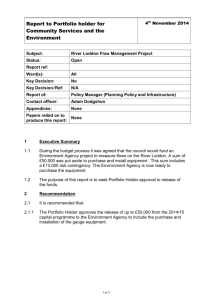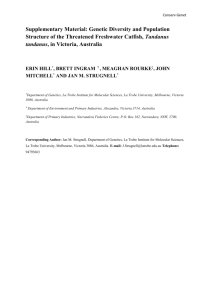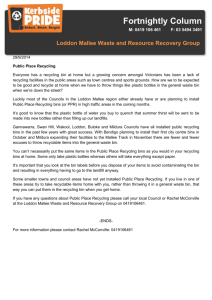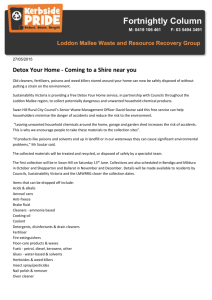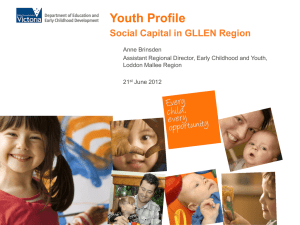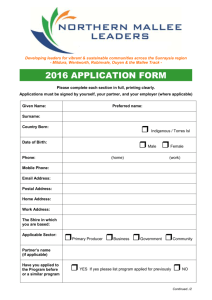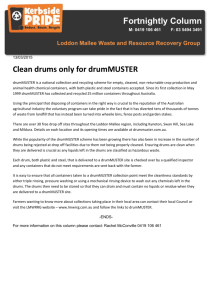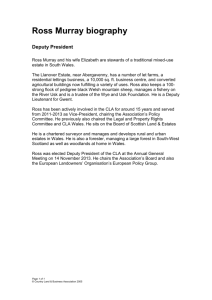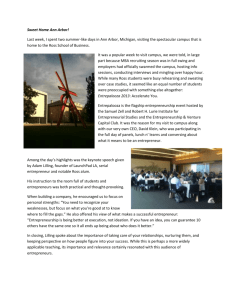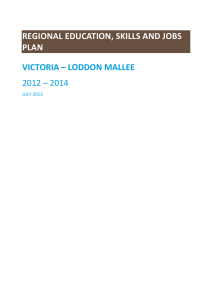Case study Loddon Mallee Government
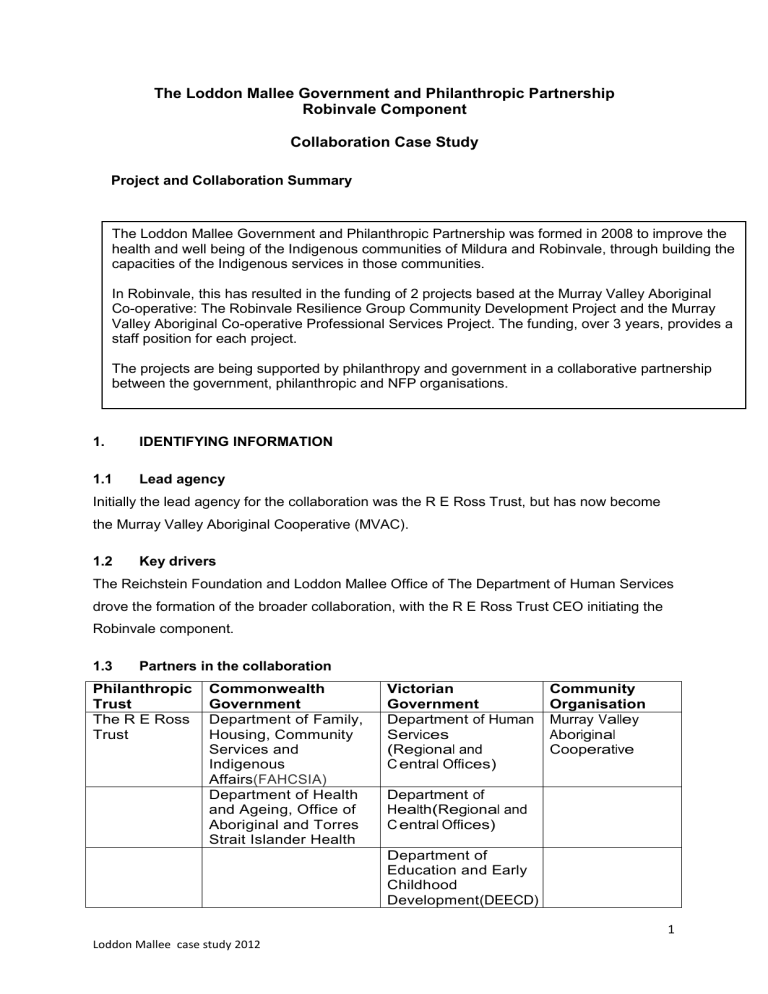
The Loddon Mallee Government and Philanthropic Partnership
Robinvale Component
Collaboration Case Study
Project and Collaboration Summary
1.
The Loddon Mallee Government and Philanthropic Partnership was formed in 2008 to improve the health and well being of the Indigenous communities of Mildura and Robinvale, through building the capacities of the Indigenous services in those communities.
In Robinvale, this has resulted in the funding of 2 projects based at the Murray Valley Aboriginal
Co-operative: The Robinvale Resilience Group Community Development Project and the Murray
Valley Aboriginal Co-operative Professional Services Project. The funding, over 3 years, provides a staff position for each project.
The projects are being supported by philanthropy and government in a collaborative partnership between the government, philanthropic and NFP organisations.
IDENTIFYING INFORMATION
1.1 Lead agency
Initially the lead agency for the collaboration was the R E Ross Trust, but has now become the Murray Valley Aboriginal Cooperative (MVAC).
1.2 Key drivers
The Reichstein Foundation and Loddon Mallee Office of The Department of Human Services drove the formation of the broader collaboration, with the R E Ross Trust CEO initiating the
Robinvale component.
1.3 Partners in the collaboration
Philanthropic
Trust
The R E Ross
Trust
Commonwealth
Government
Department of Family,
Housing, Community
Services and
Indigenous
Affairs (FAHCSIA)
Department of Health and Ageing, Office of
Aboriginal and Torres
Strait Islander Health
Victorian
Government
Department of Human
Services
(Regional and
C entral Offices)
Community
Organisation
Murray Valley
Aboriginal
Cooperative
Department of
Health(Regional and
C entral Offices)
Department of
Education and Early
Childhood
Development(DEECD)
1
Loddon Mallee case study 2012
1.4 Date commenced
The Robinvale collaboration formally commenced in November 2008
1.5 Purpose of the collaboration
The overall aim of the collaboration is to improve the outcomes for the Indigenous communities of Mildura and Robinvale, through building the capacities of the Indigenous services in those communities.
The specific purpose and focus of the Robinvale Component was clarified, following a strategic planning and consultation process.
2. BACKGROUND AND IMPETUS FOR THE ESTABLISHMENT OF THE
COLLABORATION
2.1 History and background
The Loddon Mallee partnership originally grew from a forum held in June 2008 in
Echuca, facilitated by the Reichstein Foundation and the Department of Human
Services Loddon Mallee Office. It brought together Aboriginal communities from across the Loddon Mallee, with a range of philanthropic foundations to discuss possible grants and the findings from research that had been undertaken on the issues both the Mildura and Robinvale communities were facing.
Following the forum a site visit was organised to services in both Mildura and Robinvale, at which specific projects were discussed.
In April and July 2009, the CEO of The R E Ross Trust visited Robinvale to meet with a range of potential stakeholders to better understand the issues confronting the community, and, in particular, the issues impacting on the Murray Valley Aboriginal Cooperative's (MVAC) capacity to work with the community. As a result of these discussions, it was decided that the R E Ross Trust would 'take a lead' in Robinvale and support the work of the MVAC.
This led to the creation of 2 projects based at MVAC, each with a fulltime staff position. One is c a l l e d T h e R o b i n v a l e R e s i l i e n c e G r o u p C o m m u n i t y
D e v e l o p m e n t P r o j e c t , targeting the community and community development activity. The second is The MVAC Professional Services Project and provides a staff services coordinator to assist the CEO as well as work to support the other program managers.
2
Loddon Mallee case study 2012
2.2 Nature of participation of other partners
The collaboration has involved significant in-kind and financial contributions from the partners, and each of the partners has had a genuine stake in the project.
''It was never just a question of the MVAC coming to the funding bodies seeking financial support. Prior to any funding being granted there was input from all the interested parties and considerable negotiation. The actual funding for the two positions evolved after many discussions and a significant strategic planning exercise. People came round the table, responding to issues identified in the research".
Rebekah Lautman, R E Ross Trust
The collaboration came about because there was a general recognition that Robinvale was in crisis and had had been experiencing complex and chronic issues over a long period. A range of funders had come and gone, had started something and then moved on. Issues hadn’t been resolved, so there was a degree of mistrust and some fraught relationships between the community and government, as well as with other funders.
This history became a driving force for the collaboration , as people felt an immediate moral obligation to do something, and were very aware that things had to be done differently than in the past. Each party was willing to put in time well in excess of their normal workload.
The recognition by all parties that there were a number of very complex issues facing the town, led to early discussions about the need for people to talk about how they felt and what was important to them. Throughout these discussions, both the philanthropic and government partners have remained committed despite their being some difficult and confronting periods.
As one of the partners to the collaboration said: "You needed to show resilience yourself, take negative comments on the chin and not just walk away if you don't like what's being said. Sometimes you need to have broad shoulders and a lantern jaw".
Michael Oerelemans, Department of Human Services
Getting to know the other parties in the collaboration was therefore considered vitally important. It was clear that the potential funders were not going to provide financial resources to the project, or begin to trust each other, until there was a shared confidence.
The first few months of the partnership were not about anything specific - just getting to know each other and sharing information, before there was any discussion about specific projects.
3
Loddon Mallee case study 2012
As the collaboration evolved, it became clear that the Robinvale collaboration would be different from many others. It is a broad community development project, with many different facets, and with organisations becoming engaged as it became relevant for them. This has meant that the collaboration has been quite organic and fluid, rather than static or fixed.
Different organisations and people with different expertise and skill sets are now active in different parts of the project as it aligns with their interests and focus. There are many entry points into the collaboration.
Initially, the R E Ross Trust wasn't sure if it would provide funds beyond the initial research phase, but its involvement has developed through travelling, talking and identifying the role that it could play. This was also true for Government which, after making an initial funding commitment, have now agreed to stay for the long haul, not start something and then leave after 12 months.
Over time, as the collaboration has developed, the lead agency role has shifted from the R E
Ross Trust to MVAC. MVAC is now at the centre, with the collaboration partners providing structure and process for a range of activities and projects being developed across the community.
2.3 Process for the development and work of the collaboration
In 2009/2010, the R E Ross Trust funded a consultant to undertake intensive strategic planning with MVAC, including its Board, CEO and senior staff. The R E Ross
Trust staff also attended the strategic planning sessions. As a result, a number of gaps were identified by MVAC. These were the projects (2 positions) that were eventually funded through a range of government departments and the R E Ross
Trust.
The R E Ross Trust travelled to Robinvale on numerous occasions to provide support, expertise and t o participate in planning for the improvement of services and coordination in the community. In addition to the Ross Trust’s funding commitment, the financial value of time and travel is estimated to be in the vicinity of $100,000 over two years.
4
Loddon Mallee case study 2012
2.4 Major milestones and relevant timelines
February 2010 - June 2010: Strategic Planning was completed and projects were developed, including position descriptions.
July 2010: Funding was committed by a range of Government Departments and the R E Ross Trust - totalling $515,000 to be used over three years.
MVAC and partners then proceeded to finalise position descriptions.
Sept 2010: Positions advertised but due to resignation of MVAC CEO, interviews are delayed until new CEO was appointed.
Nov 2010: New CEO appointed.
Dec 2010: Interviews for the positions take place but no appointment made.
Delays to project implementation occurred for a number of reasons.
March - June 2011: All funding from Government Departments released.
June2011: Interviews held in Robinvale and both positions were filled.
2.5 Governance arrangements
Currently, the broader Loddon Murray partnership meets quarterly. This includes the projects separately funded in Mildura.
In Robinvale a separate funders partnership has been created to assist manage the relationships and granting aspects of the program. This group was meeting monthly originally, but less often now. It is quite fluid and can meet more frequently when there are specific jobs to achieve.
The collaboration is in the process of evaluating and clarifying its governance arrangements.
2.6 Current status of the collaboration
The collaboration is currently 6 months into the three year funding commitment. The two project staff have been employed and are engaged in developing, with the collaboration partners, a number of projects and activities which are already starting to demonstrate benefits for the community. These include resilience workshops and lateral violence forums, which explore and challenge the ways in which members of the community can engage in harmful behaviours against each other as part of an oppressed group, within families, organisations and the broader community. Other projects focus on developing improved structures and processes at the Co-op to enable better co-ordination/case management, staff training and development.
5
Loddon Mallee case study 2012
2.7 Success factors
The most important success factor has been the commitment made by all parties to the collaboration, combined with their willingness to take the necessary time to build trust, not just between the partners, but across the community as well. The building of trust was greatly facilitated by the commitment to making site visits and taking the time to have face to face contact with other partners.
With the trust came flexibility and an ability to acknowledge and accept that in a complex community development initiative, there will be organic growth and a fluidity that may not occur in other collaborations. This has clearly been successfully achieved.
The willingness to communicate frankly has been a very important component of the collaboration’s success. There were times when partners didn't want to have the difficult conversations, but in doing so they have strengthened relationships
The collaboration has also built the confidence of MVAC staff and has helped to develop a strong sense of direction for the organisation and its programs. It has also brought expertise and new thinking into the town through the active participation of the collaborating partners.
One of the strengths of the collaboration is that it has provided timely, updated information, so that parties can form their own opinions. It has also given the government partners a different window into the town. They are no longer having to just rely on rumour or hearsay. It has given them the opportunity to talk to others in the collaboration and get a different view.
This has enhanced the capacity to work across and outside government.
Above all, the collaboration has assisted to develop answers to som e of the town’s chronic problems. These would not have been arrived at by any organisation and/or funding body working on their own.
2.8 Major challenges
One of the biggest challenges has been to recognise the importance of documenting the history of the collaboration and ensuring that when staff change there is someone who takes responsibility for sharing knowledge and the history with new team members.
CEOs at both MVAC and the R E Ross Trust have changed during the collaboration and this has had implications for the passing on of knowledge and information. At MVAC had there been a more formalised process to ensure that this was done, it may have taken less time to build the relationship with the new MVAC CEO and to clarify the specific projects and relationships.
6
Loddon Mallee case study 2012
3.
Collaborations create extra work on top of a normal workload and finding the time and energy to take them on can be a challenge. While this has been a challenge it has also been one of the success factors. The collaboration has clearly demonstrated that all parties have in fact remained engaged and committed to the partnership and its goals throughout the lengthy negotiation period, often involving difficult discussions.
2.9 Evaluation
The collaboration is being formally evaluated by the research firm, Social Compass.
Each of the funding partners contributed funds for the evaluation which will track its history and development, capture the learnings from the approach and assess its usefulness as a model for other geographic locations or policy areas. If the evaluation finds that the approach is effective, it is hoped that this will encourage others to work in this way.
ASSESSMENT OF THE COLLABORATION AGAINST EACH
DRAFT GUIDING PRINCIPLE
3.1
Understand each other’s roles, policies, priorities and limitations
Collaboration partners were relatively clear about each others roles and policies, but less sure about priorities and unclear about limitations (as was true for all the case studies). As the Collaboration’s purpose evolved over time, the roles, priorities and limitations changed and this was especially evident when key people in the partnership left.
3.2 Engage each other early when the potential idea/interest/need for a collaborative approach is being considered
All of the partners were involved at an early stage in the collaboration, so were engaged in the process of determining purpose, goals and projects.
3.3 Clarify expectations
Given the changes in key personnel early on in the collaboration, there needed to be a rethink of roles, responsibilities and expectations, as well as clarification and confirmation of the decisions made in relation to the specific projects.
3.4 Ensure sufficient time to develop trust and agreed approaches
Again, because of the change in one of the key partners, having time to re-establish trust in the relationships and the approach was essential. It was agreed that this had been achieved, with time taken in travelling to have face-to-face meetings greatly assisting to build relationships and commitment during transition and difficult situations.
7
Loddon Mallee case study 2012
“The first few months of the partnership were not about anything specific – just getting to know each other and sharing information, before there was any discussion of specific projects”.
Rebekah Lautman, R E Ross Trust
3.5 Agree to processes for selecting organisations to be funded and the nature of projects to be jointly supported
The process for identifying and agreeing to the projects to be supported has been a genuinely collaborative one amongst the partners.
3.6 Ensure the right people are at the table
This has evolved into a genuine partnership between government, philanthropy and
Indigenous community organisation. The need to involve both senior decision makers and the doers from each organisation, and recognising the importance of having the right people at the table at the right time when decisions have to be made was important. It is also important that there was consistency, not changing staff members at every meeting.
Establishment of a separate Robinvale funders group has been very effective in managing the granting aspects of the collaboration.
3.7 Ensure there is an evaluation framework
A formal evaluation of the collaboration is being undertaken with funding from the partners .
3.8 Develop an exit strategy for both or either party
An exit strategy has been developed for the formally funded projects. However, the partners are currently discussing the overall future of the broader collaboration. This may involve moving or expanding to other communities in the Loddon Mallee region.
3.9 Communicate frankly throughout the collaboration time frame
This collaboration has experienced some challenging moments, and the trusting relationships built over time have allowed open and frank communication when it has been needed. This has strengthened the collaboration and partnerships. “Communicating frankly is very important …relationships have been stressed at times, but ultimately have been enhanced – no-one is walking away, even when things get difficult”.
Michael Oerelemans, Department of Human Services
8
Loddon Mallee case study 2012
3.10 Develop a memorandum of understanding (MOU)
The term MOU has a very specific legal meaning, particularly for the federal government which is a partner and will not sign up to an MOU. The collaboration is now developing a
‘Statement of I ntent’, agreeing to principles, goals and approaches – it needed time to evolve, wouldn’t have been clear about what to include in it earlier on.
3.11 Other comments
Participation in this coll aboration has enhanced partners’ capacity to work across and outside their own sectors. What’s been learnt can now be applied to other collaborations, knowing better how to get everybody’s needs and priorities met. It includes communication, negotiation, p lus sympathy and respect for others’ perspectives.
Loddon Mallee case study 2012
9
